Extreme Graphics Testing
Now, we've had a look at the graphics comparison in Lost Planet: Extreme Condition before, focusing on the differences between the DirectX 9 and DirectX10 versions, but that doesn't mean we shouldn't go back and have a look at the graphics again. After all, graphics are what we do here at bit-tech and we love an excuse to crawl through the game getting comparative screenshot.Well, okay, it's not actually as much fun as it sounds having to shut down games and then take a single screenshot, repeating the cycle hundreds of times and then examining the pictures closely - but we do it because we love our community.
Lost Planet is an undeniably gorgeous game too and the graphics offered up in either the DirectX 9 or DirectX 10 version, the choice of which is left to gamers when launching through Steam, are full of hi-res textures and some of the most stunning smoke effects we've seen since Call of Duty 2 sent us off in coughing fits.
Motion blur is one of the features used the most in Lost Planet, sometimes used a little bit too much in fact as, everytime the player stumbles or turns quickly there is a nauseating blur on the screen. A lot of the enemies in the game also use motion blur effects, unveiling annoying spinning attacks and slams that shake the entire screen. Sometimes it's done to great effect, such as when Wayne first meets Green Eye, and other times its used to the game's detriment, say for example when attacked over and over by spinning Akrid foes.
Animation is the one major strength in Lost Planet's graphical arsenal however because, no matter how good the smoke and flame effects look, it's the realistic animations which really increase the immersion. Wayne in particular is well animated as he hops up into the various Vital Suits or wades through snowdrifts with a rocket launcher. His animations are handled expertly, right down to the realisitic stumbling which occurs when a grenade goes off nearby and leaves him momentarily concussed.
Lost Planet: Extreme Condition has a lot of variables in the graphics menu too, but from our past experience we were quickly able to recognise the important settings which would affect the performance and the most noticeable graphical difference. We've picked those out now to break down and compare so that you can see exactly what you'll end up seeing in the game itself.
We took the following comparative screenshots on a system running Windows Vista (I was finally forced to upgrade), with an Nvidia GeForce 8800 GTS and 2GB of RAM in it - which comprises our first DX10 gaming specific rig.
Anti-aliasing
Anti-aliasing, or AA, is the process by which vertices are smoothened out in a computer game to stop the appearance of 'jaggies' which would otherwise plague the image. The effect of AA is most easily spotted on items like power-lines or wire fences - anything where there are definite edges which appear at a number of different angles.The AA available in Lost Planet consists of the following selection; 2x, which is low, 4x, which is medium, and 8x, which is high.
The difference between 2x and 4x AA seems to be negligible at best and, to be honest, if it isn't detectable and this screenshot then it won't be detectable anywhere as the vast, vast majority of the game is spent wading through snowstorms which blot out a substantial amount of the viewable area.
Still, maybe 8x AA will show a bigger difference?
The edges are slightly smoother and some really close examination reveals a few tiny differences but by and large the 2x or 4x AA is going to be enough to get a good looking game and pushing up to 8x AA is only going to sacrifice performance for a largely non-detectable benefit. Of course, if you've got lots of performance spare, you could increase anti-aliasing to 8x on your GeForce 8800.
Effects Volume
The volume of the effects is an important consideration in Lost Planet, as it controls the density of the snow clouds which sweep across the levels and also the size and amount of the other various effects, such as smoke and fireballs, which really show off how good Lost Planet looks.Effects volume is divided into two settings - low or high. We have screenshots of both below, so check them out.
At first there's very little noticeable difference in the above screenshots, but take another look at the upper right part of the image and compare how much of the distance you can see. You can see much less of the distance in the higher setting, which is actually a good thing because it means the snow clouds are thicker and more dense.
Increasing the slider here has a massive effect not just on how the game looks, but also on how gamers may play the game. Less snow means more viewable area and more accuracy, but more snow means a better looking game but more of a challenge. The game is pathetically easy with a keyboard and mouse though, so there's no real downside to pushing this setting up to maximum if you've got the graphical grunt to handle the extra rendering.

MSI MPG Velox 100R Chassis Review
October 14 2021 | 15:04


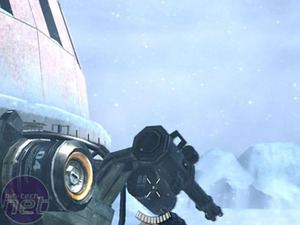
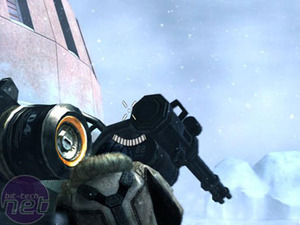
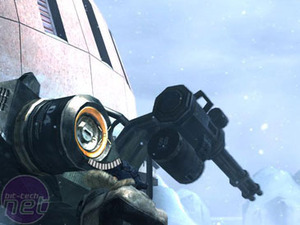
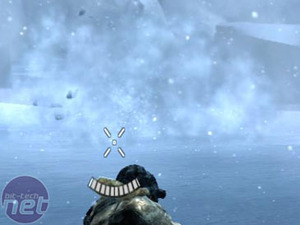
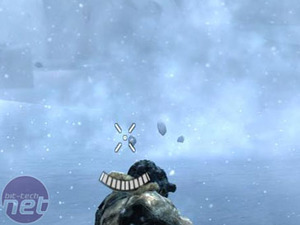









Want to comment? Please log in.